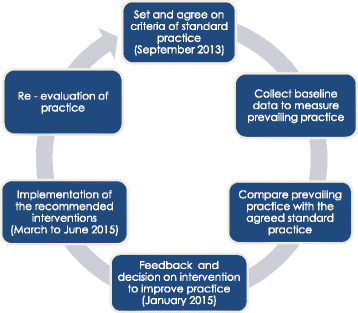Criteria-based audit to improve quality of care of foetal distress: standardising obstetric care at a national referral hospital in a low resource setting, Tanzania
- PMID: 27825311
- PMCID: PMC5101816
- DOI: 10.1186/s12884-016-1137-z
Criteria-based audit to improve quality of care of foetal distress: standardising obstetric care at a national referral hospital in a low resource setting, Tanzania
Abstract
Background: In Tanzania, substandard intrapartum management of foetal distress contributes to a third of perinatal deaths, and the majority are term deliveries. We conducted a criteria-based audit with feedback to determine whether standards of diagnosis and management of foetal distress would be improved in a low-resource setting.
Methods: During 2013-2015, a criteria-based audit was performed at the national referral hospital in Dar es Salaam. Case files of deliveries with a diagnosis of foetal distress were identified and audited. Two registered nurses under supervision of a nurse midwife, a specialist obstetrician and a consultant obstetrician, reviewed the case files. Criteria for standard diagnosis and management of foetal distress were developed based on international and national guidelines, and literature reviews, and then, stepwise applied, in an audit cycle. During the baseline audit, substandard care was identified, and recommendations for improvement of care were proposed and implemented. The effect of the implementations was assessed by the differences in percentage of standard diagnosis and management between the baseline and re-audit, using Chi-square test or Fisher's exact test, when appropriate.
Results: In the baseline audit and re-audit, 248 and 251 deliveries with a diagnosis of foetal distress were identified and audited, respectively. The standard of diagnosis increased significantly from 52 to 68 % (p < 0.001). Standards of management improved tenfold from 0.8 to 8.8 % (p < 0.001). Improved foetal heartbeat monitoring using a Fetal Doppler was the major improvement in diagnoses, while change of position of the mother and reduced time interval from decision to perform caesarean section to delivery were the major improvements in management (all p < 0.001). Percentage of cases with substandard diagnosis and management was significantly reduced in both referred public and non-referred private patients (all p ≤ 0.01) but not in non-referred public and referred private patients.
Conclusion: The criteria-based audit was able to detect substandard diagnosis and management of foetal distress and improved care using feedback and available resources.
Keywords: Caesarean section; Criteria-based audit; Fetal Doppler; Foetal distress; Low-resource setting.
Similar articles
-
Improved quality of management of eclampsia patients through criteria based audit at Muhimbili National Hospital, Dar es Salaam, Tanzania. Bridging the quality gap.BMC Pregnancy Childbirth. 2012 Nov 21;12:134. doi: 10.1186/1471-2393-12-134. BMC Pregnancy Childbirth. 2012. PMID: 23170817 Free PMC article.
-
Improving Standards of Care in Obstructed Labour: A Criteria-Based Audit at a Referral Hospital in a Low-Resource Setting in Tanzania.PLoS One. 2016 Nov 28;11(11):e0166619. doi: 10.1371/journal.pone.0166619. eCollection 2016. PLoS One. 2016. PMID: 27893765 Free PMC article.
-
Criteria-based audit on management of eclampsia patients at a tertiary hospital in Dar es Salaam, Tanzania.BMC Pregnancy Childbirth. 2009 Mar 27;9:13. doi: 10.1186/1471-2393-9-13. BMC Pregnancy Childbirth. 2009. PMID: 19323846 Free PMC article.
-
Death audits and reviews for reducing maternal, perinatal and child mortality.Cochrane Database Syst Rev. 2020 Mar 25;3(3):CD012982. doi: 10.1002/14651858.CD012982.pub2. Cochrane Database Syst Rev. 2020. PMID: 32212268 Free PMC article.
-
The diagnosis of foetal distress: a challenge to midwives.J Adv Nurs. 1996 May;23(5):975-83. doi: 10.1046/j.1365-2648.1996.09917.x. J Adv Nurs. 1996. PMID: 8732526 Review.
Cited by
-
Evaluation of criterion-based audit in improving quality of neonatal birth asphyxia care at Balaka district hospital in Malawi.Matern Health Neonatol Perinatol. 2024 Nov 4;10(1):21. doi: 10.1186/s40748-024-00191-7. Matern Health Neonatol Perinatol. 2024. PMID: 39491034 Free PMC article.
-
Perceptions and experiences of skilled birth attendants on using a newly developed strap-on electronic fetal heart rate monitor in Tanzania.BMC Pregnancy Childbirth. 2019 May 10;19(1):165. doi: 10.1186/s12884-019-2286-7. BMC Pregnancy Childbirth. 2019. PMID: 31077139 Free PMC article.
-
Is time of birth a predictor of adverse perinatal outcome? A hospital-based cross-sectional study in a low-resource setting, Tanzania.BMC Pregnancy Childbirth. 2017 Jun 12;17(1):184. doi: 10.1186/s12884-017-1358-9. BMC Pregnancy Childbirth. 2017. PMID: 28606111 Free PMC article.
-
Survey of Diagnostic Criteria for Fetal Distress in Latin American and African Countries: Over Diagnosis or Under Diagnosis?J Clin Diagn Res. 2017 Jun;11(6):SL01-SL02. doi: 10.7860/JCDR/2017/27374.10034. Epub 2017 Jun 1. J Clin Diagn Res. 2017. PMID: 28764259 Free PMC article. No abstract available.
-
Improved maternal-fetal outcomes among emergency obstetric referrals following phone call communication at a teaching hospital in south western Uganda: a quasi-experimental study.BMC Pregnancy Childbirth. 2022 Sep 5;22(1):684. doi: 10.1186/s12884-022-05007-0. BMC Pregnancy Childbirth. 2022. PMID: 36064375 Free PMC article. Clinical Trial.
References
-
- Mdegela M, Muganyizi P, Pembe A, Simba D, Van Roosmalen J. How rational are indications for emergency caesarean section in a tertiary hospital in Tanzania? Tanzania J Health Res. 2012;14(4):1–8. - PubMed
Publication types
MeSH terms
LinkOut - more resources
Full Text Sources
Other Literature Sources


